Neural Network Modelling for Prediction of Zeta Potential
Abstract
1. Introduction
2. Proposal for Experiments
2.1. Materials
2.2. Zeta Potential Measurements
2.3. Proposal of an Artificial Neural Network Architecture for Prediction
- Activation function is the hyperbolic tangent;
- Learning coefficient for the first 5000 learning cycles, then it decreases to ;
- Momentum .
3. Results and Discussions
3.1. Experimental Zeta Potential
3.2. Artificial Neural Network
4. Comparison with Other Academic Works
5. Conclusions
6. Highlights
- The artificial neural network is a good tool for predicting the zeta potential of nanoparticles;
- The use of an artificial neural network allows for the determination of zeta potential values also for such conditions that cannot be realized;
- Prediction of zeta potential using an artificial neural network can save time and resources.
Author Contributions
Funding
Conflicts of Interest
References
- Liu, Q.; Chen, Z.; Yang, Y. Study of the Air-Entraining Behavior Based on the Interactions between Cement Particles and Selected Cationic, Anionic and Nonionic Surfactants. Materials 2020, 13, 3514. [Google Scholar] [CrossRef]
- Ferrari, L.; Kaufmann, J.; Winnefeld, F.; Plank, J. Interaction of cement model systems with superplasticizers investigated by atomic force microscopy, zeta potential, and adsorption measurements. J. Colloid Interface Sci. 2010, 347, 15–24. [Google Scholar] [CrossRef]
- Plank, J.; Hirsch, C. Impact of zeta potential of early cement hydration phases on superplasticizer adsorption. Cem. Concr. Res. 2007, 37, 537–542. [Google Scholar] [CrossRef]
- Morfesis, A.; Jacobson, A.M.; Frollini, R.; Helgeson, M.; Billica, J.; Gertig, K.R. Role of Zeta (ζ) Potential in the Optimization of Water Treatment Facility Operations. Ind. Eng. Chem. Res. 2009, 48, 2305–2308. [Google Scholar] [CrossRef]
- Fazullin, D.D.; Mavrin, G.V.; Shaikhiev, I.G. Particle Size and Zeta Potential Changes in the Disperse Phase of Water-Emulsified Waste Waters in Different Treatment Stages. Chem. Technol. Fuels Oils 2015, 51, 501–505. [Google Scholar] [CrossRef]
- Fang, K.; Gao, H.; Sun, F.; Chen, W.; Xie, R.; Cai, Y. Effect of glass transition temperatures and zeta potentials of cationic copolymer latexes on pigment dyeing. Fibers Polym. 2017, 18, 2255–2260. [Google Scholar] [CrossRef]
- Abidi, N.; Semhi, K.; Trabelsi-Ayadi, M. Removal of anionic dye from textile industries’ effluents by using Tunisian clays as adsorbents. Ζeta potential and streaming-induced potential measurements. Comptes Rendus Chim. 2019, 22, 113–125. [Google Scholar] [CrossRef]
- Fuerstenau, D.W. Zeta potentials in the flotation of oxide and silicate minerals. Adv. Colloid Interface Sci. 2005, 114, 9–26. [Google Scholar] [CrossRef] [PubMed]
- Multani, R.S.; Williams, H.; Johnson, B.; Li, R.; Waters, K.E. The effect of superstructure on the zeta potential, xanthate adsorption, and flotation response of pyrrhotite. Colloids Surf. A Physicochem. Eng. Asp. 2018, 551, 108–116. [Google Scholar] [CrossRef]
- Speers, R.A.; Durance, T.D.; Tung, M.A.; Tou, J. Colloidal properties of flocculent and nonflocculent brewing yeast suspensions. Biotechnol. Prog. 1993, 9, 267–272. [Google Scholar] [CrossRef]
- Li, J.; Joung, H.J.; Lee, I.W.; Chen, X.; Park, H.J. The influence of different water types and brewing durations on the colloidal properties of green tea infusion. Int. J. Food Sci. Technol. 2015, 50, 2483–2489. [Google Scholar] [CrossRef]
- Biriukov, D.; Fibich, P.; Předota, M. Zeta Potential Determination from Molecular Simulations. J. Phys. Chem. C 2020, 124, 3159–3170. [Google Scholar] [CrossRef]
- Ovanesyan, Z.; Aljzmi, A.; Almusaynid, M.; Khan, A.; Valderrama, E.; Nash, K.L.; Marucho, M. Ion–ion correlation, solvent excluded volume and pH effects on physicochemical properties of spherical oxide nanoparticles. J. Colloid Interface Sci. 2016, 462, 325–333. [Google Scholar] [CrossRef] [PubMed][Green Version]
- Vinogradov, J.; Jackson, M.D.; Chamerois, M. Zeta potential in sandpacks: Effect of temperature, electrolyte pH, ionic strength and divalent cations. Colloids Surf. A Physicochem. Eng. Asp. 2018, 553, 259–271. [Google Scholar] [CrossRef]
- Liu, X.; Mäki-Arvela, P.; Aho, A.; Vajglova, Z.; Gun’ko, V.M.; Heinmaa, I.; Kumar, N.; Eränen, K.; Salmi, T.; Murzin, D.Y. Zeta Potential of Beta Zeolites: Influence of Structure, Acidity, pH, Temperature and Concentration. Molecules 2018, 23, 946. [Google Scholar] [CrossRef]
- Shih, Y.H.; Liu, W.S.; Su, Y.F. Aggregation of stabilized TiO2 nanoparticle suspensions in the presence of inorganic ions. Environ. Toxicol. Chem. 2012, 31, 1693–1698. [Google Scholar] [CrossRef]
- Marsalek, R. Particle Size and Zeta Potential of ZnO. APCBEE Procedia 2014, 9, 13–17. [Google Scholar] [CrossRef]
- Suganthi, K.S.; Rajan, K.S. Temperature induced changes in ZnO–water nanofluid: Zeta potential, size distribution and viscosity profiles. Int. J. Heat Mass Transf. 2012, 55, 7969–7980. [Google Scholar] [CrossRef]
- Asadi, A.; Asadi, M.; Siahmargoi, M.; Asadi, T.; Andarati, M.G. The effect of surfactant and sonication time on the stability and thermal conductivity of water-based nanofluid containing Mg(OH)2 nanoparticles: An experimental investigation. Int. J. Heat Mass Transf. 2017, 108, 191–198. [Google Scholar] [CrossRef]
- Mucha, M.; Maršálek, R.; Bukáčková, M.; Zelenková, G. Interaction among clays and bovine serum albumin. RSC Adv. 2020, 10, 43927–43939. [Google Scholar] [CrossRef]
- Marsalek, R.; Pospisil, J.; Taraba, B. The influence of temperature on the adsorption of CTAB on coals. Colloids Surf. A Physicochem. Eng. Asp. 2011, 383, 80–85. [Google Scholar] [CrossRef]
- Peterson, K.L. Artificial Neural Networks and Their use in Chemistry. In Reviews in Computational Chemistry; John Wiley & Sons, Inc.: Hoboken, NJ, USA, 2007; pp. 53–140. [Google Scholar]
- Duch, W.; Diercksen, G.H.F. Neural networks as tools to solve problems in physics and chemistry. Comput. Phys. Commun. 1994, 82, 91–103. [Google Scholar] [CrossRef]
- Zupan, J.; Novič, M.; Ruisánchez, I. Kohonen and counterpropagation artificial neural networks in analytical chemistry. Chemom. Intell. Lab. Syst. 1997, 38, 1–23. [Google Scholar] [CrossRef]
- Kazemi-Beydokhti, A.; Azizi Namaghi, H.; Asgarkhani, H.; Zeinali Heris, S. Prediction of stability and thermal conductivity of sno2nanofluid via statistical method and an artificial neural network. Braz. J. Chem. Eng. 2015, 32, 903–917. [Google Scholar] [CrossRef]
- Karimipour, A.; Ghasemi, S.; Darvanjooghi, M.H.K.; Abdollahi, A. A new correlation for estimating the thermal conductivity and dynamic viscosity of CuO/liquid paraffin nanofluid using neural network method. Int. Commun. Heat Mass Transf. 2018, 92, 90–99. [Google Scholar] [CrossRef]
- Kannaiyan, S.; Boobalan, C.; Nagarajan, F.C.; Sivaraman, S. Modeling of thermal conductivity and density of alumina/silica in water hybrid nanocolloid by the application of Artificial Neural Networks. Chin. J. Chem. Eng. 2019, 27, 726–736. [Google Scholar] [CrossRef]
- Hashad, R.A.; Ishak, R.A.H.; Fahmy, S.; Mansour, S.; Geneidi, A.S. Chitosan-tripolyphosphate nanoparticles: Optimization of formulation parameters for improving process yield at a novel pH using artificial neural networks. Int. J. Biol. Macromol. 2016, 86, 50–58. [Google Scholar] [CrossRef]
- Tekeli, F.N. Application of artificial neural networks for Zeta potential of copolymer. Bulg. Chem. Commun. 2017, 49, 146–150. [Google Scholar]
- Yukselen, Y.; Erzin, Y. Artificial neural networks approach for zeta potential of Montmorillonite in the presence of different cations. Environ. Geol. 2008, 54, 1059–1066. [Google Scholar] [CrossRef]
- Asadi, A.; Moayedi, H.; Huat, B.B.; Boroujeni, F.Z.; Parsaie, A.; Sojoudi, S. Prediction of Zeta Potential for Tropical Peat in the presence of different Cations using Artificial Neural Networks. Int. J. Electrochem. Sci. 2011, 6, 1146–1158. [Google Scholar]
- Li, H.; Chen, F.; Cheng, K.; Zhao, Z.; Yang, D. Prediction of Zeta Potential of Decomposed Peat via Machine Learning: Comparative Study of Support Vector Machine and Artificial Neural Networks. Int. J. Electrochem. Sci. 2015, 10, 6044–6056. [Google Scholar]
- Imanparast, F.; Faramarzi, M.A.; Paknejad, M.; Kobarfard, F.; Amani, A.; Doosti, M. Preparation, optimization, and characterization of simvastatin nanoparticles by electrospraying: An artificial neural networks study. J. Appl. Polym. Sci. 2016, 133, 43602. [Google Scholar] [CrossRef]
- Erzin, Y.; Yukselen, Y. The Use of Neural Networks for the Prediction of Zeta Potential of Kaolinite. Math. Geosci. 2009, 41, 779–797. [Google Scholar] [CrossRef]
- Zhao, F.; Lu, J.; Jin, X.; Wang, Z.; Sun, Y.; Gao, D.; Li, X.; Liu, R. Comparison of response surface methodology and artificial neural network to optimize novel ophthalmic flexible nano-liposomes: Characterization, evaluation, in vivo pharmacokinetics and molecular dynamics simulation. Colloids Surf. B Biointerfaces 2018, 172, 288–297. [Google Scholar] [CrossRef]
- Liu, H.H.; Lanphere, J.; Walker, S.; Cohen, Y. Effect of hydration repulsion on nanoparticle agglomeration evaluated via a constant number Monte–Carlo simulation. Nanotechnology 2015, 26, 045708. [Google Scholar] [CrossRef] [PubMed]
- Bouhaik, I.S.; Leroy, P.; Ollivier, P.; Azaroual, M.; Mercury, L. Influence of surface conductivity on the apparent zeta potential of TiO2 nanoparticles: Application to the modeling of their aggregation kinetics. J. Colloid Interface Sci. 2013, 406, 75–85. [Google Scholar] [CrossRef]
- Bukackova, M.; Rusnok, P.; Marsalek, R. Mathematical Methods in the Calculation of the Zeta Potential of BSA. J. Solut. Chem. 2018, 47, 1942–1952. [Google Scholar] [CrossRef]
- Jiang, Y.; Sulgani, M.T.; Ranjbarzadeh, R.; Karimipour, A.; Nguyen, T.K. Hybrid GMDH-type neural network to predict fluid surface tension, shear stress, dynamic viscosity & sensitivity analysis based on empirical data of iron(II) oxide nanoparticles in light crude oil mixture. Phys. A Stat. Mech. Its Appl. 2019, 526, 120948. [Google Scholar]
- Hasani Bijarbooneh, F.; Zhao, Y.; Kim, J.H.; Sun, Z.; Malgras, V.; Aboutalebi, S.H.; Heo, Y.U.; Ikegami, M.; Dou, S.X. Aqueous Colloidal Stability Evaluated by Zeta Potential Measurement and Resultant TiO2 for Superior Photovoltaic Performance. J. Am. Ceram. Soc. 2013, 96, 2636–2643. [Google Scholar] [CrossRef]
- Gómez-Merino, A.I.; Rubio-Hernández, F.J.; Velázquez-Navarro, J.F.; Aguiar, J. Assessment of ζ-potential in TiO2 aqueous suspensions: A comparative study based on thermodynamic and rheological methods. Ceram. Int. 2015, 41, 5331–5340. [Google Scholar] [CrossRef]
- Wang, N.; Hsu, C.; Zhu, L.; Tseng, S.; Hsu, J.P. Influence of metal oxide nanoparticles concentration on their zeta potential. J. Colloid Interface Sci. 2013, 407, 22–28. [Google Scholar] [CrossRef] [PubMed]
- Masters, T. Practical Neural Network in C++; Academic Press: Cambridge, MA, USA, 1993. [Google Scholar]
- Rojas, R. Neural Networks; Springer: Berlin/Heidelberg, Germany, 1996. [Google Scholar]
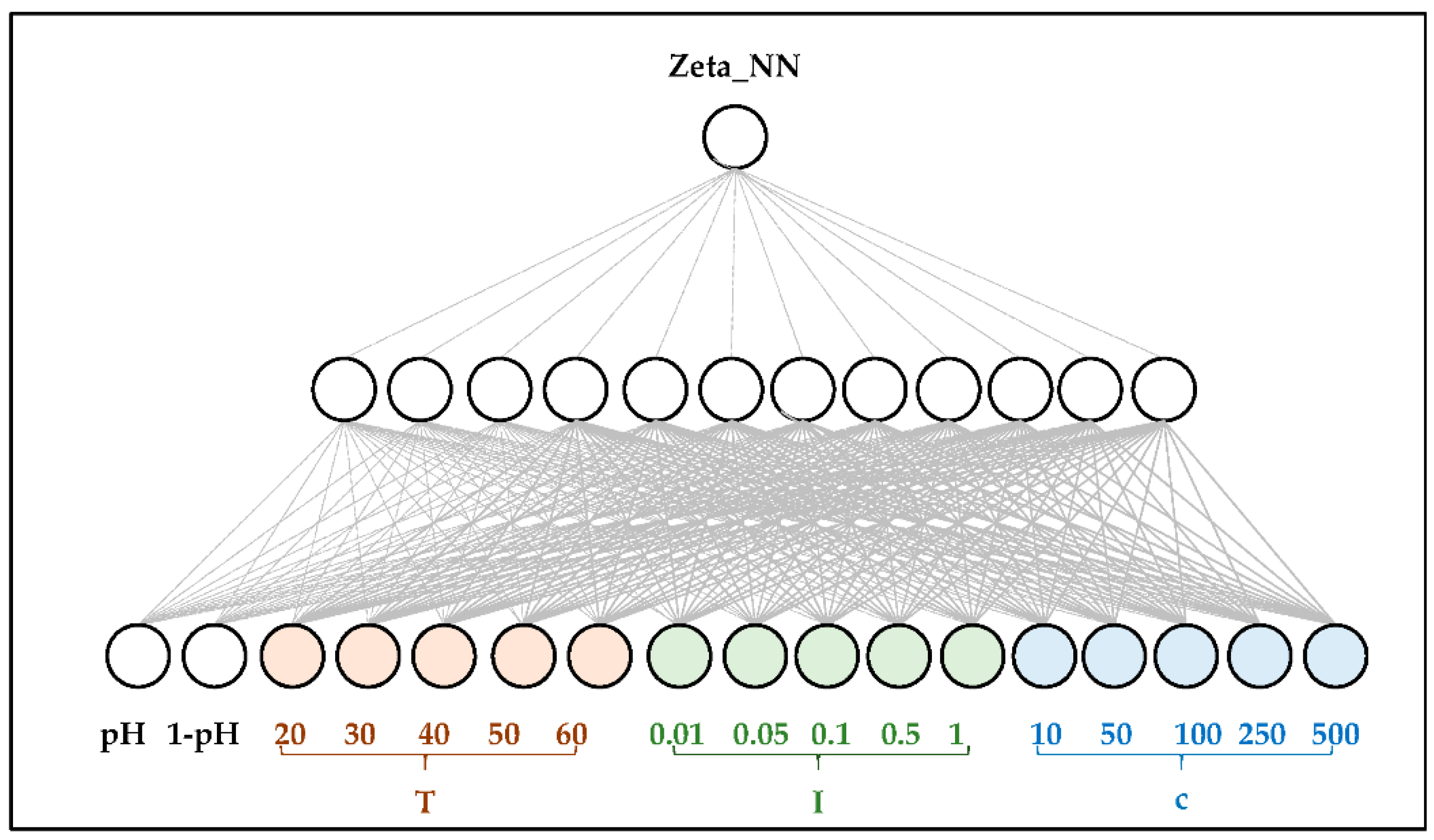
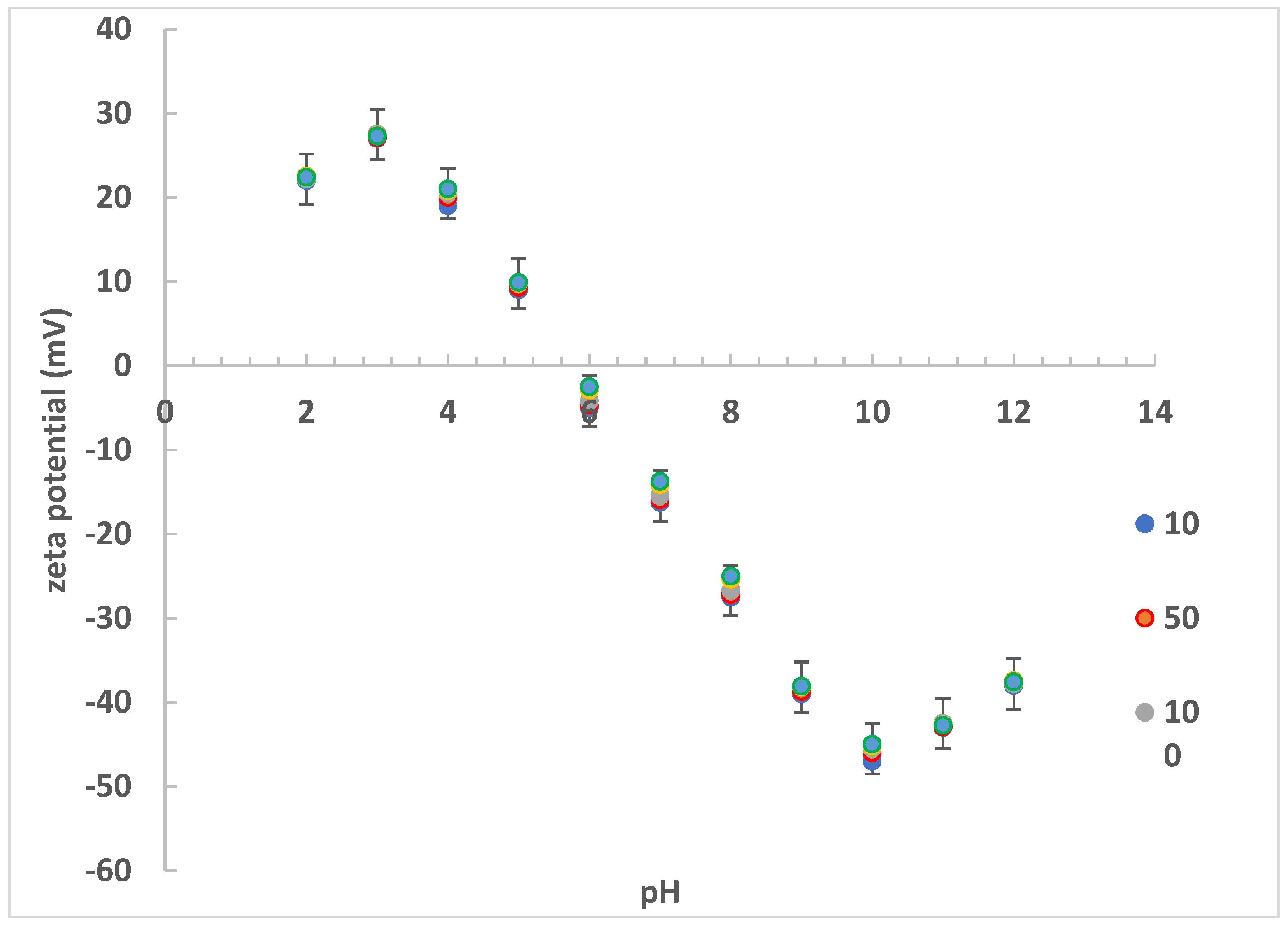
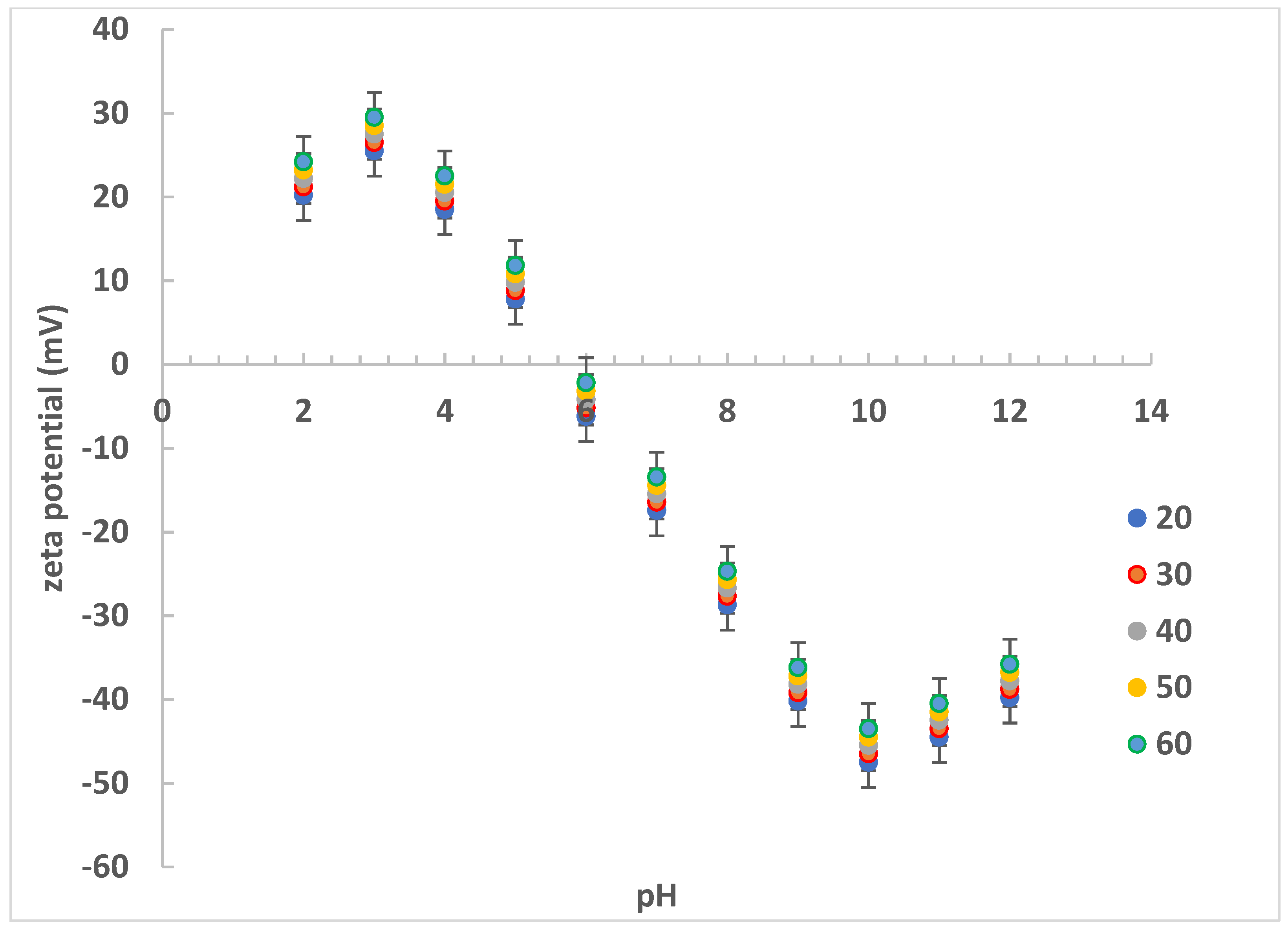
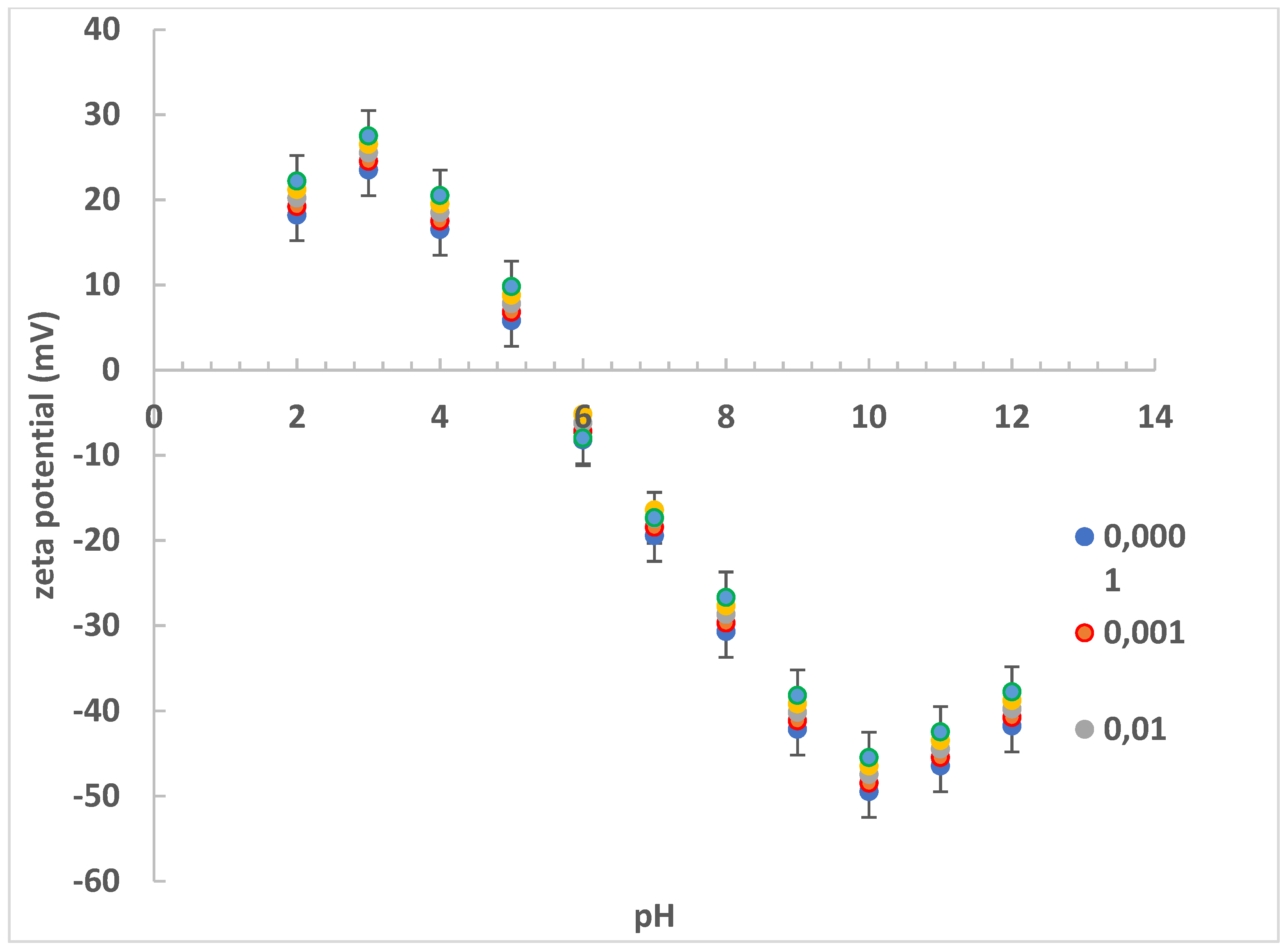
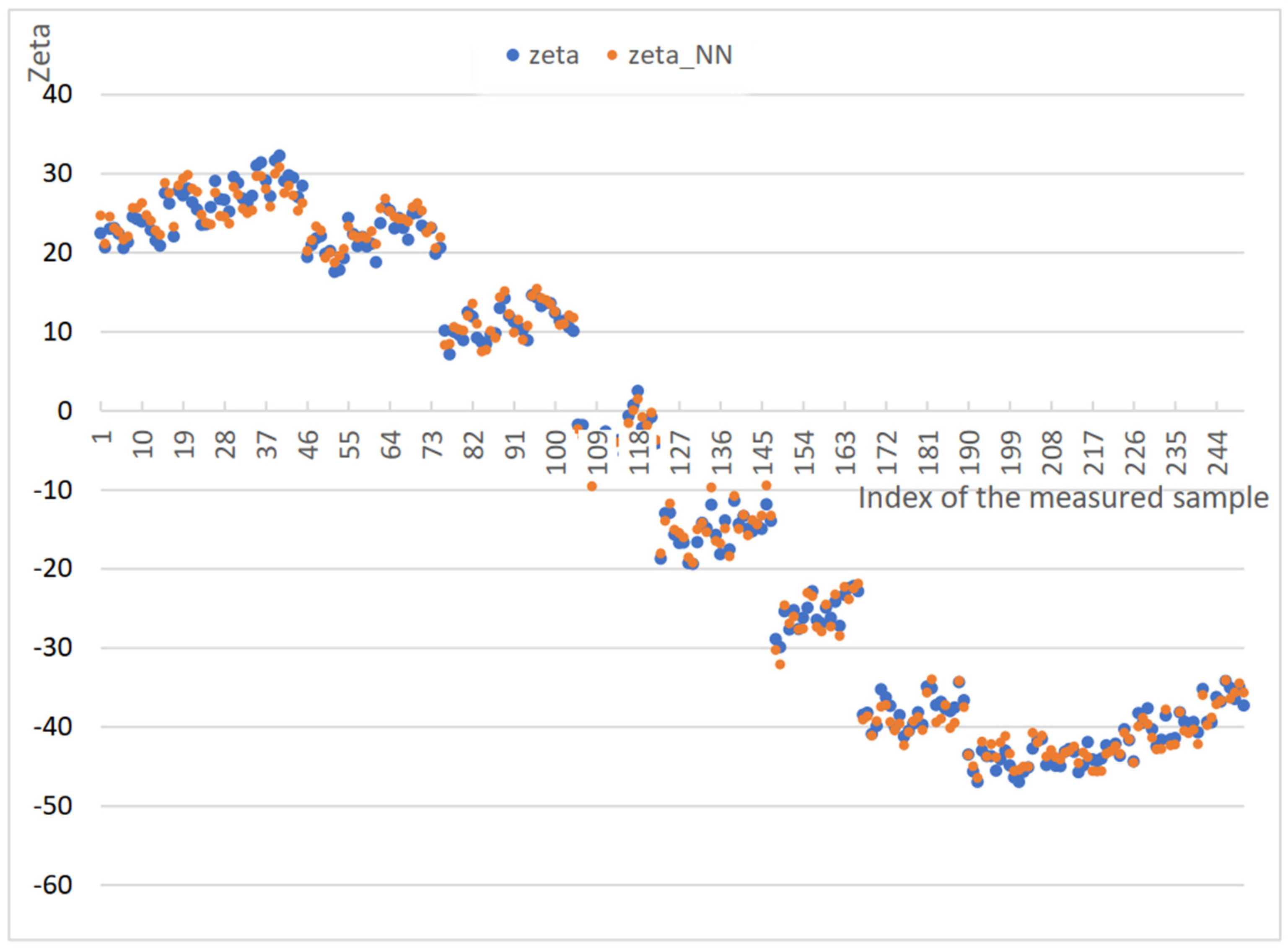

| Quantity | Values | NN Representation | Number of Neurons | |
|---|---|---|---|---|
| Input vector | pH | range 2–12.29 | Transformed to interval [−1, 1] | 1 |
| 1-pH | Transformed to interval [−1, 1] | 1 | ||
| T | 20, 30, 40, 50, 60 | Binarized, values 0 or 1 | 5 | |
| I | 0.01; 0.05; 0.1; 0.5; 1 | Binarized, values 0 or 1 | 5 | |
| c | 10; 50; 100; 250; 500 | Binarized, values 0 or 1 | 5 | |
| Output vector | Zeta_NN | [−60, 70] | Transformed from interval [−1, 1] | 1 |
| Correlation coefficient R | 0.99907 |
| The coefficient of determination R2 | 0.99814 |
| Number of measurements | 250 |
| SS (Sum of Squares) | MS (Mean Square) | F | Significance of F | |
|---|---|---|---|---|
| Regression | 190,807.8 | 190,807.8 | 133,178.7566 | 0 |
| Residues | 355.3144 | 1.432719 | ||
| Total | 191,163.1 |
| Model (Test Set) | Neural Network | The Coefficient of Determination R2 | |
|---|---|---|---|
| Our approach | TiO2 | MLP | 0.998 |
| Yukselen, Y.; Erzin, Y. [30] | Montmorillonite—Salt | MLP | 0.947 |
| Montmorillonite—Heavy Metal | 0.902 | ||
| Asadi, A. et al. [19] | Peat | MLP | 0.9504 |
| Lia, H. et al. [32] | Decomposed Peat | SVM | 0.923 |
| GRNN | 0.923 | ||
| Erzin, Y.; Yukselen, Y. [34] | the kaolinite—Salt | MLP | 0.992 |
| the kaolinite—Heavy Metal | 0.996 |
Publisher’s Note: MDPI stays neutral with regard to jurisdictional claims in published maps and institutional affiliations. |
© 2021 by the authors. Licensee MDPI, Basel, Switzerland. This article is an open access article distributed under the terms and conditions of the Creative Commons Attribution (CC BY) license (https://creativecommons.org/licenses/by/4.0/).
Share and Cite
Marsalek, R.; Kotyrba, M.; Volna, E.; Jarusek, R. Neural Network Modelling for Prediction of Zeta Potential. Mathematics 2021, 9, 3089. https://doi.org/10.3390/math9233089
Marsalek R, Kotyrba M, Volna E, Jarusek R. Neural Network Modelling for Prediction of Zeta Potential. Mathematics. 2021; 9(23):3089. https://doi.org/10.3390/math9233089
Chicago/Turabian StyleMarsalek, Roman, Martin Kotyrba, Eva Volna, and Robert Jarusek. 2021. "Neural Network Modelling for Prediction of Zeta Potential" Mathematics 9, no. 23: 3089. https://doi.org/10.3390/math9233089
APA StyleMarsalek, R., Kotyrba, M., Volna, E., & Jarusek, R. (2021). Neural Network Modelling for Prediction of Zeta Potential. Mathematics, 9(23), 3089. https://doi.org/10.3390/math9233089








